Culture environment interacts with intestinal microbial communities
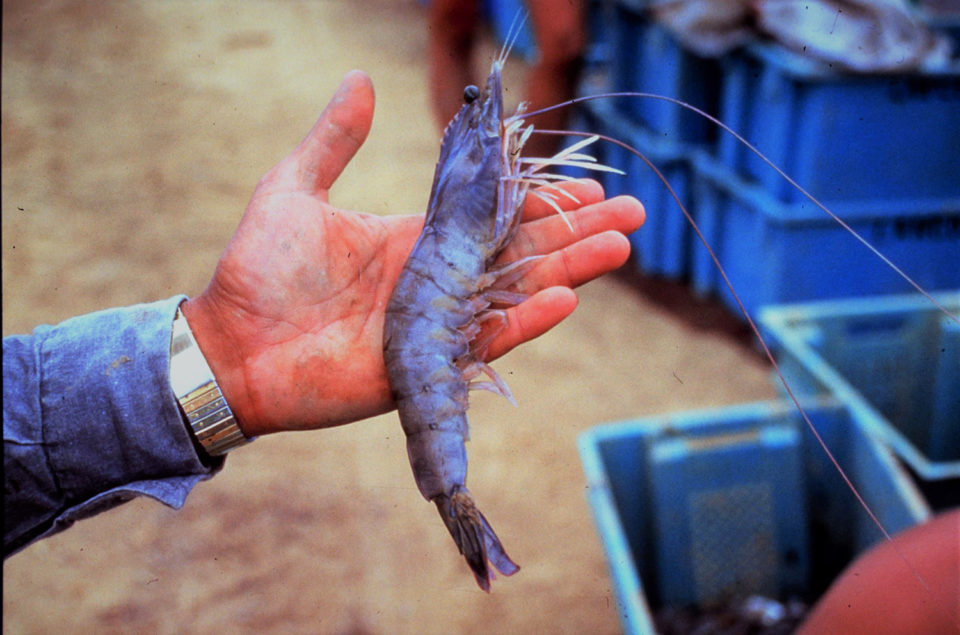
In shrimp biofloc technology (BFT) systems, the resulting, significant microbial community can serve as a pond water quality treatment system and the microbial protein produced can be utilized by the shrimp as feed. One issue of shrimp BFT systems is the difficulty of controlling the biofloc bacterial community composition for both optimal water quality and optimal animal health. Thus, a research priority is to assess, measure and describe the complex microbial biofloc community and to develop methods that will establish diverse and stable microbial communities.
It is assumed by many authors that, by consuming natural productivity, shrimp ingest the bacteria present on the food particles. We also know that the composition of aquatic bacterial communities in ponds has a strong influence on the internal bacterial microbiota of farmed marine animals; this can play a role in nutrition, immunity and disease resistance of the cultured animals. However, there is limited, available information on the bacterial communities present in the rearing water or on the interaction of this microbial environment with bacteria of the shrimp microbiota. An important step for the improvement and optimization of biofloc technology is the characterization and control of its microbial community.
This article – adapted and summarized from the original publication – reports on a study to characterize microbial communities of water samples obtained from different shrimp (Pacific blue shrimp, Litopenaeus stylirostris) culture environments (biofloc technology and clear seawater) as well as from the guts of shrimp reared in both environments, and to evaluate the impact of the culture environment on shrimp microbiota.
Study setup
Pacific blue shrimp juveniles (weighing 4.45 ± 1.27 grams) were randomly assigned for 35 days to two types of growing conditions, both of which had an initial mean shrimp biomass of 900 grams per square meter: clear seawater (CW) and biofloc technology (BFT). The experiment was conducted in 18 outdoor 250-liter polyester tanks at the Centre Technique Aquacole de Vairao, French Polynesia (Aquaculture Technical Center of Tahiti), with six replicates for CW water and 12 replicates for BFT tanks.
Each tank was continuously aerated and covered with a shade net to limit sunlight (70 percent inhibition of light). Tank water was daily exchanged at 300 percent in the CW treatment and 3 percent in the BFT treatment. To balance the carbon:nitrogen (C:N) ratio and encourage the development of heterotrophic bacteria in the BFT, sugarcane molasses was added daily to obtain a C:N of 20:1. Shrimp were fed twice a day with a commercial shrimp feed grower with 40 percent protein.
Once a week, 60 mL of BFT rearing water were sampled per tank and filtered through a 0.22-μm filter. CW rearing water was sampled in the same manner but only twice during rearing period; we considered that with the higher water renewal (300 percent per day), bacterial communities did not change during rearing and assumed that the composition and diversity of original influent was very similar to that of the CW rearing system. At the end of the experiment, shrimp were not fed for 24 hours before sampling. Three animals were then randomly sampled from each tank and their intestines dissected and preserved for various lab analyses.
For detailed information on the experimental design; shrimp husbandry; water quality monitoring; water and intestine sampling; DNA extraction; PCR amplification of 16SrNA genes and next-generation sequencing; and data analysis, refer to the original publication.
Results and discussion
For bacterial diversity and composition in BFT and CW rearing water, a total of 4,141,873 sequences were obtained for rearing-water with an average of 108,997 reads per sample (n = 38). Sequences were clustered into operational taxonomic units (OTUs; an operational definition used to classify groups of closely related individuals) at the 0.97 similarity level. OTU richness of water varied from 435.02 ± 55.81 per sample in the CW treatment to 277.59 ± 23.02 in the BFT treatment.
Although the bacterial diversity was similar, the frequency distribution of bacterial phyla differed between the treatments (Table 1). Proteobacteria was the most abundant phylum in water from both treatments. In this study, its relative abundance ranged between 50.4 percent for CW and 60.0 percent for BFT. This phylum is widely dispersed in the marine environment and plays an important role in the process of nutrient cycling and the mineralization of organic compounds.
Cardona, blue shrimp, Table 1
| Bacteria phyla | CW | BFT |
|---|
Bacteria phyla | CW | BFT |
|---|---|---|
| Proteobacteria | 50.4 | 60.07 |
| Bacteroidetes | 30.04 | 21.86 |
| Cyanobacteria | 12.96 | 8.48 |
| Euryarchaeota | 2.77 | 0 |
| Actinobacteria | 2.2 | 2.13 |
| Planctomycetes | 0.36 | 1.58 |
| Verrumibrobia | 0.33 | 1.37 |
| Chloroflexi | 0.31 | 0.31 |
| Crenarchaeota | 0.17 | 0 |
Bacteroidetes was the second most abundant phylum, with a relative abundance ranging from 30.0 percent for CW and 21.9 percent for BFT. This phylum is a dominant member of marine heterotrophic bacterioplankton and is frequently found colonizing macroscopic organic matter particles. Finally, Cyanobacteria was the third most abundant phylum, with a relative abundance ranging from 13.0 percent for CW to 8.5 percent for BFT. Altogether, these three phyla represented more than 90 percent of the total bacteria.
In BFT water, Leucothrix (20.1 percent), Rhodobacteraceae (16.4 percent), Stramenopiles (8.0 percent), Oceanospirillaceae (5.5 percent) and Saprospiraceae (4.7 percent) were the most dominant operational taxonomic units. In the CW conditions, Cryomorphaceae (24.6 percent), Pelagibacteraceae (10.1 percent), Stramenopiles (8.4 percent), Glaciecola (5.6 percent) and Colwelliaceae (4.9 percent) were the most represented taxa.
A high level of variability in the most frequent bacterial communities was evidenced over the course of BFT rearing (Fig. 1) that could be due to changes in biotic and abiotic environmental factors. In the BFT system, several physicochemical and biological parameters such as chlorophyll a (Chl a), nitrite nitrogen and total ammonia nitrogen changed over time, whereas these parameters were stable and close to zero in the CW system (Fig. 2).
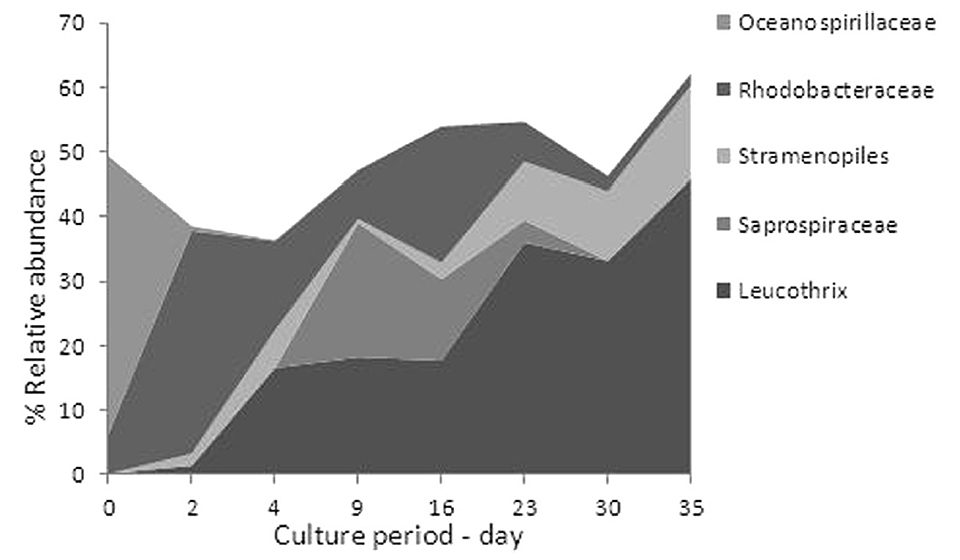
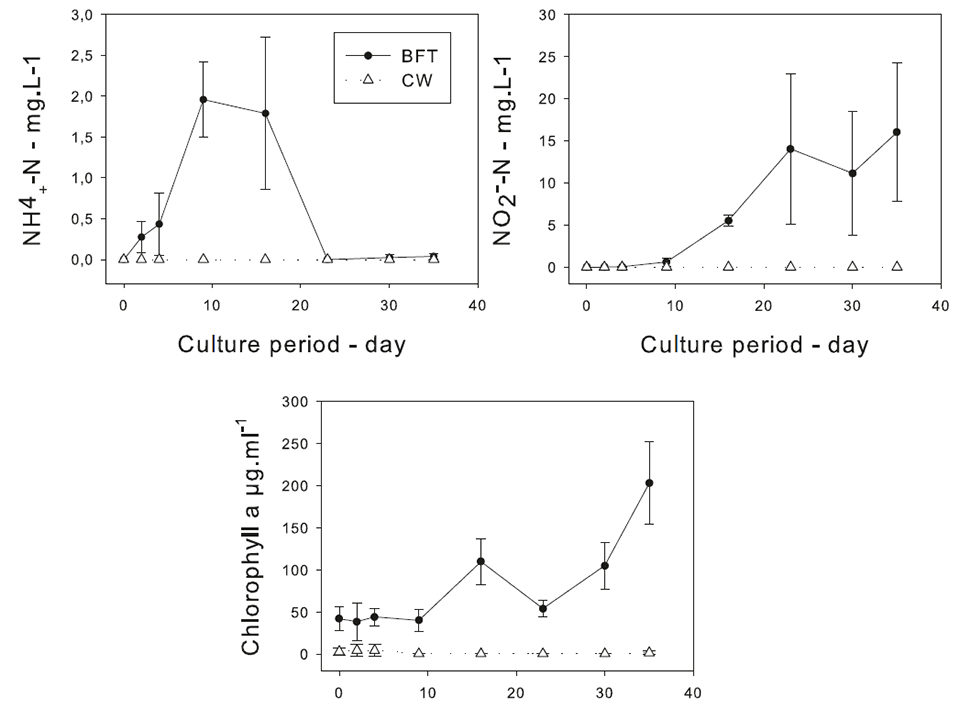
In our study, the Rhodobacteraceae family could have limited the survival of pathogenic bacteria in the BFT compared with the CW environment. Another suggestion to explain the lower Vibrio abundance in BFT is that bioflocs displayed biocontrol activity against Vibrio harveyi, the virulence of which can be regulated by the process of cell-to-cell communication called quorum sensing.
We observed that the CW environment harbored communities of bacterial genera that were distinct from those found in the BFT environment. Indeed, results from similarity percentages revealed that profiles of water samples from each treatment were distinct, with 89 percent dissimilarity. Similarity percentage analysis showed that the genera Photobacterium, Leucothrix and Vibrio were the three principal taxa at the root of the dissimilarity (16.5, 12.1 and 4.1 percent, respectively) between water samples from the two treatments.
We can explain the difference in bacterial communities between the BFT and CW environments by the high levels of organic matter and nutrient concentrations present in biofloc. The biofloc treatment was characterized by bacteria belonging to taxa such as Gammaproteobacteria Thiotrichaceae Leucothrix, Alphaproteobacteria Rhodobacteraceae and Bacteroidetes Saprospiraceae, which can use organic matter and nitrogen compounds for growth and require a substrate to grow on. These two conditions are found in the BFT system, which is particularly rich in organic matter and suspended particles in the water column.
A total of 963,352 sequences were obtained for intestine samples, with an average of 118,843 reads per CW sample (n = 3) and 151,702 reads per BFT sample (n = 4). The OTU richness of intestine samples varied from 239.00 ± 31.11 per sample in the CW treatment to 196.25 ± 9.00 in the BFT treatment. The relative abundance of major order bacteria in the intestine samples from both types of growing conditions is presented in Table 2.
Cardona, blue shrimp, Table 2
| Taxa | CW | BFT |
|---|
Taxa | CW | BFT |
|---|---|---|
| Gammaproteobacteria Vibrionales | 69.18 | 58.6 |
| Alphaproteobacteria Rhodobacterales | 12.99 | 2.02 |
| Chloroplast Stramenopiles | 10.53 | 0.14 |
| Bacteroidia Bacteroidales | 0.01 | 6.74 |
| Flavobacteriia Flavobacteriales | 1.87 | 5.53 |
| Gammaproteobacteria Alteromonadales | 1.57 | 1.11 |
| Mollicutes | 1.29 | 5.95 |
The shrimp had not eaten any commercial feed for 24 hours before sampling, and the BFT and CW libraries from intestine samples were mostly dominated by one order affiliated to Gammaproteobacteria Vibrionales. This order is better represented in intestines from CW-reared shrimp (69.2 percent of total sequences) than those from BFT-reared shrimp (58.6 percent of total sequences). This group of bacteria has previously been reported at high relative abundance in the intestines of other species of shrimps such as Litopenaeus vannamei, Penaeus monodon and Fenneropenaeus chinensis.
The Pseudoalteromonadaceae family represented 8.2 and 0.8 percent in the shrimp intestines from the CW and BFT treatments, respectively. The Vibrionaceae family represented 57.6 and 54.5 percent in shrimp intestine from the CW and BFT treatments, respectively. Photobacterium represented 82 to 89 percent of Vibrionaceae in the total sequence from all the shrimp intestines, while Vibrio accounted for the remainder.
Bacterial OTUs in rearing water and shrimp intestine were investigated with regard to treatment and are shown quantitatively in the Venn diagram in Fig. 3. The analyses revealed that 198 OTUs were shared between all sample types, which corresponds to 10.7 percent of the total OTUs. The diagram clearly emphasizes that water samples have a large pool of OTUs that are not found in the intestines [251 (24.5 percent) and 186 (28.2 percent) in water from BFT and CW, respectively, with 184 OTUs (33.6 percent) in common], which contrasts with the low number of OTUs found exclusively in intestine [12 (1.1 percent) and 16 (2.3 percent) from BFT and CW, respectively, 3 OTUs (1.5 percent) in common]. This result confirmed that the flora found in water is substantially more diverse than that of shrimp guts.
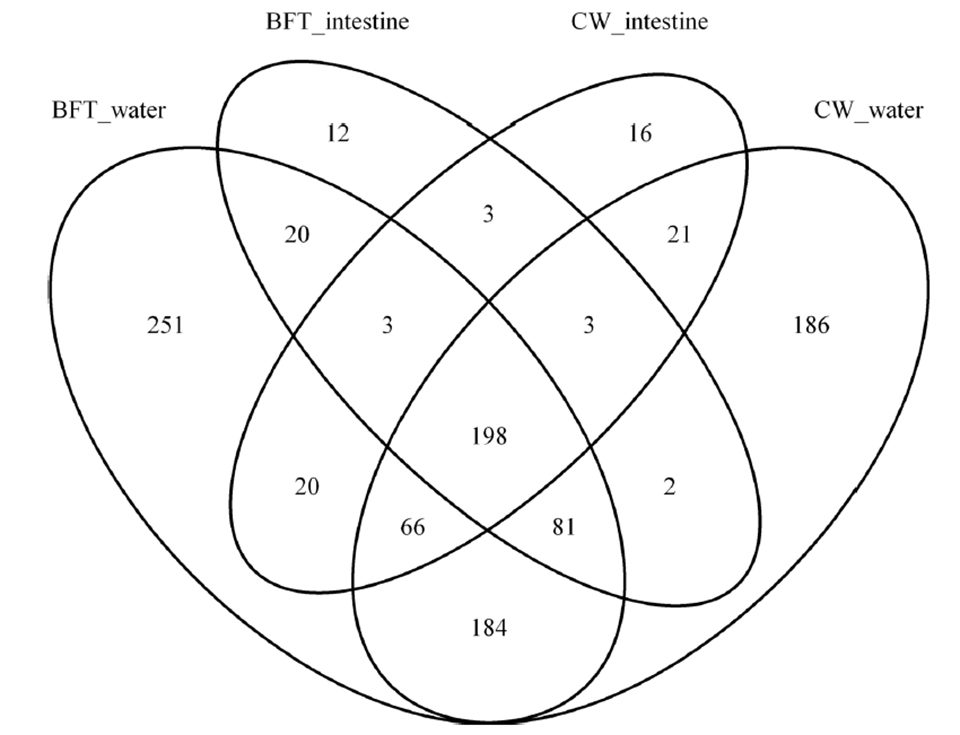
Previous investigations have proposed that the intestinal microbiota of shrimp originate from their culture environment. In our study, the profiles of intestinal bacterial communities from each treatment were distinct (only 27 percent similarity). Moreover, results showed that the composition of bacterial communities in Pacific blue shrimp intestines from the CW treatment was relatively similar to those of the rearing environment and revealed a 35 percent similarity between CW water and intestine samples. Results also suggest that the bacterial composition of BFT water influenced that of the intestine, but BFT intestine bacteria had specific differences with those from CW intestines.
Perspectives
Our study explored the diversity of bacterial communities by applying 16S RNA next-generation sequencing to different culture environments (BFT and CW) and intestines of Pacific blue shrimp reared in both environments. The results demonstrated, first, that the water harbored a remarkable diversity of bacterial communities and that four out of the five most important bacterial communities were different between culture methods. Second, this study showed that the culture environment interacted with the intestinal microbial communities.
Our research results provide descriptive information about a bacterial community associated with biofloc rearing of Pacific blue shrimp, and its influence on the animals’ intestinal microbiota, which can be further applied in more research on immunity, disease resistance and nutrition of cultured shrimp.
Now that you've reached the end of the article ...
… please consider supporting GSA’s mission to advance responsible seafood practices through education, advocacy and third-party assurances. The Advocate aims to document the evolution of responsible seafood practices and share the expansive knowledge of our vast network of contributors.
By becoming a Global Seafood Alliance member, you’re ensuring that all of the pre-competitive work we do through member benefits, resources and events can continue. Individual membership costs just $50 a year.
Not a GSA member? Join us.
Authors
-
Emilie Cardona
Ifremer, UMR 241 EIO, UPF-ILM-IRD
Labex Corail, B.P. 7004, 98719
Taravao, Tahiti, French Polynesia -
Yannick Gueguen
Ifremer, UMR 241 EIO, UPF-ILM-IRD
Labex Corail, B.P. 7004, 98719
Taravao, Tahiti, French Polynesia -
Kevin Magré
Ifremer, UMR 241 EIO, UPF-ILM-IRD
Labex Corail, B.P. 7004, 98719
Taravao, Tahiti, French Polynesia -
Bénédicte Lorgeoux
Ifremer, UMR 241 EIO, UPF-ILM-IRD
Labex Corail, B.P. 7004, 98719
Taravao, Tahiti, French Polynesia -
David Piquemal
ACOBIOM, 1682 rue de la Valsière
Cap Delta - CS77394, 34184
Montpellier Cedex 4, France -
Fabien Pierrat
ACOBIOM, 1682 rue de la Valsière
Cap Delta - CS77394, 34184
Montpellier Cedex 4, France -
Florian Noguier
ACOBIOM, 1682 rue de la Valsière
Cap Delta - CS77394, 34184
Montpellier Cedex 4, France -
Denis Saulnier
Corresponding author
Ifremer, UMR 241 EIO, UPF-ILM-IRD
Labex Corail, B.P. 7004, 98719
Taravao, Tahiti, French Polynesia
Tagged With
Related Posts

Health & Welfare
A comprehensive look at the Proficiency Test for farmed shrimp
The University of Arizona Aquaculture Pathology Laboratory has carried out the Proficiency Test (PT) since 2005, with 300-plus diagnostic laboratories participating while improving their capabilities in the diagnosis of several shrimp pathogens.
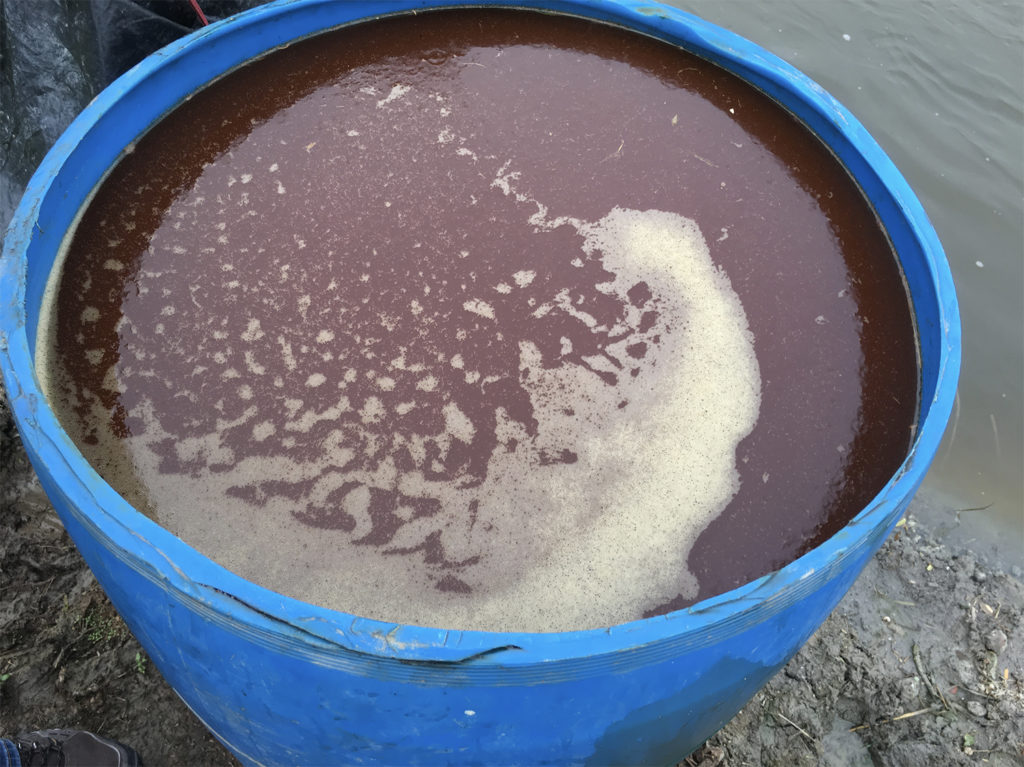
Responsibility
Bacterial amendments in shrimp grow-out ponds
Pond microbial communities are a critical and often overlooked component of aquaculture ecosystems. Bacterial amendments like probiotics provide significant support to shrimp farmers around the world.
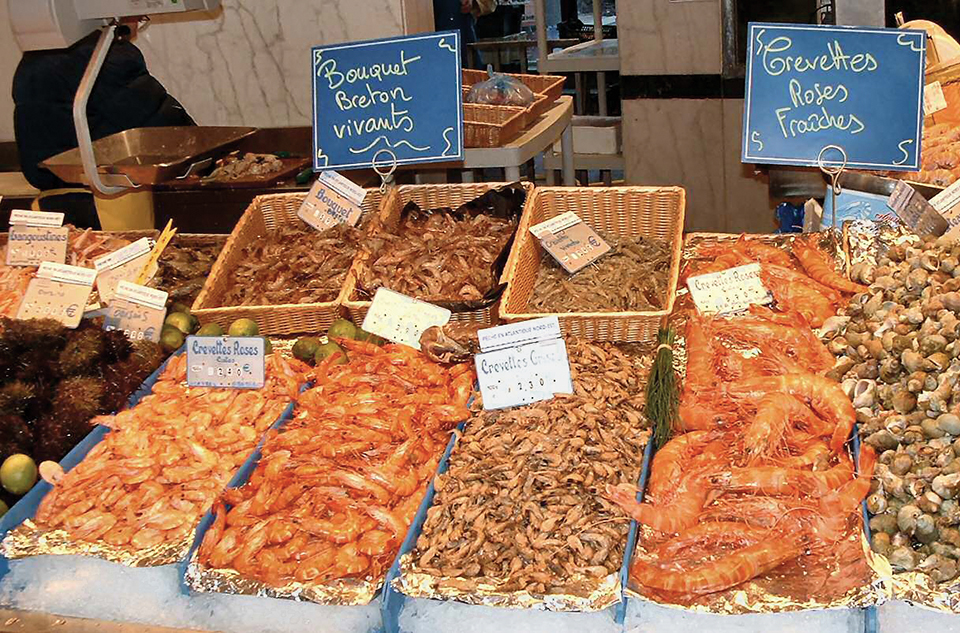
Health & Welfare
Alfalfa concentrate: natural shrimp color enhancer
Adding alfalfa concentrate containing natural carotenoids and pigments to the finishing diets of shrimp can enhance coloration of shrimp after cooking.
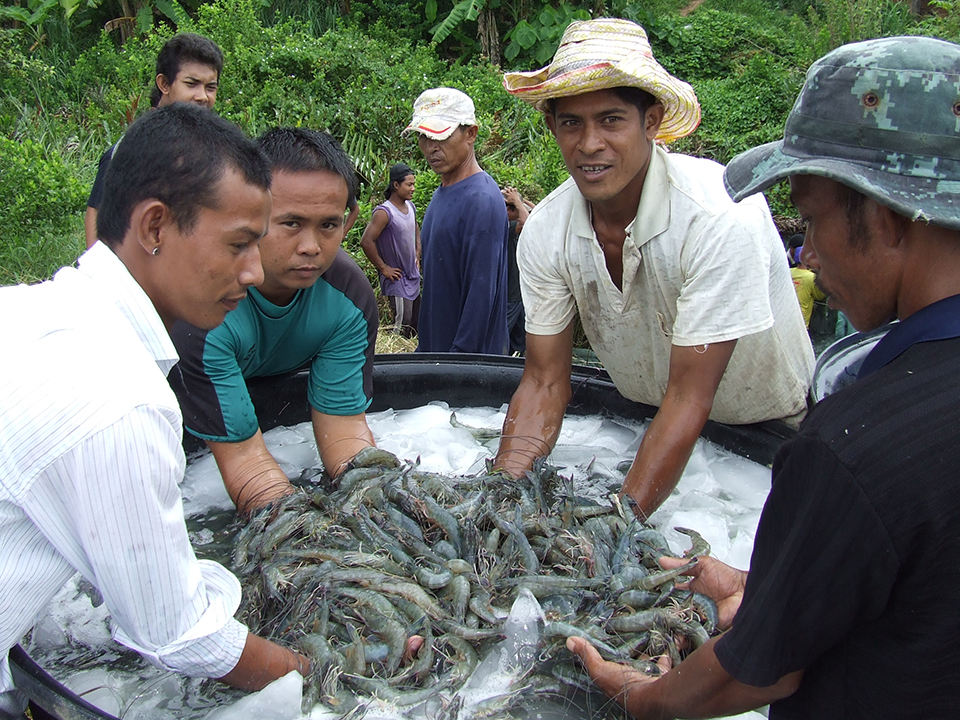
Health & Welfare
Blue alternative: High Health introduces SPF blue shrimp to Thailand
Blue shrimp are very similar to Pacific white shrimp, and can be raised under similar conditions. Blues grow faster and tolerate lower water temperatures.



